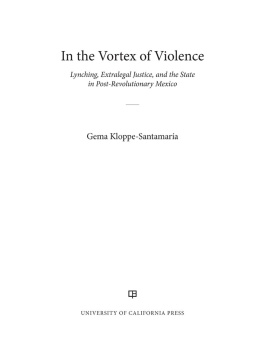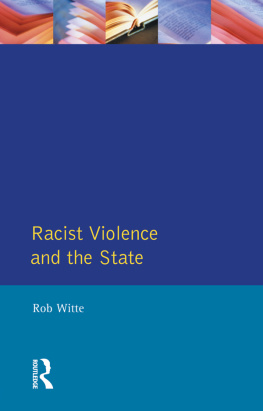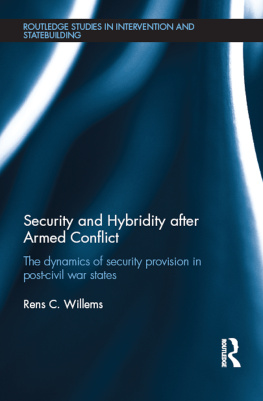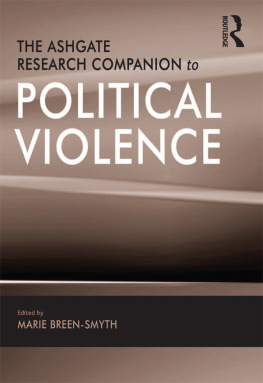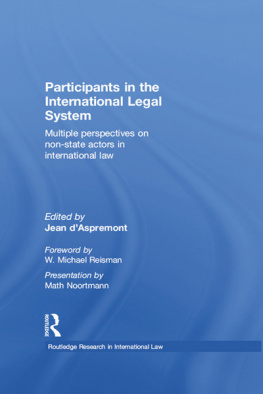Violence, Coercion, and State-Making in Twentieth-Century Mexico
The Other Half of the Centaur
Edited by Wil G. Pansters

STANFORD UNIVERSITY PRESS
STANFORD, CALIFORNIA
Stanford University Press
Stanford, California
2012 by the Board of Trustees of the Leland Stanford Junior University.
All rights reserved.
No part of this book may be reproduced or transmitted in any form or by any means, electronic or mechanical, including photocopying and recording, or in any information storage or retrieval system without the prior written permission of Stanford University Press.
Printed in the United States of America on acid-free, archival-quality paper
Library of Congress Cataloging-in-Publication Data
Violence, coercion, and state-making in twentieth-century Mexico : the other half of the centaur /edited by Wil G. Pansters.
pages cm
Includes bibliographical references and index.
ISBN 978-0-8047-8158-9 (cloth : alk. paper)
ISBN 978-0-8047-8447-4 (ebook)
1. MexicoPolitics and government20th century. 2. ViolencePolitical aspectsMexicoHistory20th century. I. Pansters, W. G. (Wil G.),
editor of compilation.
F1234.V865 2012
972.08'2dc23
2011052267
Typeset by Westchester Book Group in 10/12 Sabon
For my lovely daughter Ifigenia, whose mere presence is disarming
Table of Contents
Wil G. Pansters
David A. Shirk
Diane E. Davis
Paul Gillingham
Alan Knight
Mnica Serrano
Jos Carlos G. Aguiar
Marcos Aguila and Jeffrey Bortz
Kathy Powell
John Gledhill
Kees Koonings
Figures
Tables
Preface and Acknowledgments
When the first ideas and initiatives for this volume were taking shape, its core subjectviolence, coercion, and state-making in postrevolutionary Mexicowas slowly moving toward a more prominent position in debates, both public and scholarly. However, none of the participants at the workshop in the sunbathed center of Utrecht in June 2007 could have anticipated the spiral of violence, militarization, human rights abuses, and fear that would soon engulf Mexico. Clearly, the symptoms of a deepening security crisis were already there: in an unprecedented decision taken only a few days after our event, President Felipe Caldern purged 284 federal police commanders, including those of all thirty-one states and the Federal District. But even given such changes, anyone who had predicted then that around 15,000 people would be killed in the mayhem of drug-related violence in the year 2010 alonea daily average of more than 40!would not have been regarded as credible.
Although the escalation of violence in Mexico in the 2000s in and of itself constitutes a strong cause for scholarly reflection, it was not the only one. This volume also arose out of a critical reading of much of the recent work that has examined Mexicos major social and political developments in the wake of the neoliberal takeover and the intensification of political competition in the mid-1980s: the fraudulent 1988 presidential elections, the spectacular Salinas presidency, the annus horribilis of 1994 with NAFTA, the zapatista rebellion, the assassination of presidential candidate Luis Donaldo Colosio and the infamous errors of December, the disintegration of the PRI-government pact during the wavering presidency of Zedillo, and, finally, the spectacular rise to power of Vicente Fox and Mexicos subsequent political-electoral reconfiguration that led to the showdown between the left and the right in the 2006 presidential elections. Most of this work was, and still is, profoundly shaped by the political and scholarly discourses of transition and democratization. However, just as elsewhere in Latin America, it became gradually and disturbingly clear that the institutional reforms of democratization and transition coexisted with violent conflicts and deepening insecurity. Paradoxical sociopolitical realities, as well as contrasting scholarly accounts of those realities, began to raise new questions and problems of interpretation. What were the key features of posttransitional violence and insecurity? What are the connections between the different floors of Mexicos and Latin Americas social and political structures? What consequences does all this have for our understanding of democracy and the rule of law in the region? It is perhaps no surprise that coming to terms with these issues has recently generated such a concept as violent democracies, one that would have sounded utterly oxymoronic just a few years ago. It appears that the uncommon democracy of one-party rule has given way to the uncommon democracy of violence.
The third and final rationale for this book was that in the case of Mexico, interpretative obstacles for coming to terms with the recent wave of criminal and political violence, as well as with the contradictory features of the transition, appear to be rooted in broader understandings of the role of violence and coercion, as opposed to nonviolence or hegemony in postrevolutionary (particularly post-1940) state-making. Hence, this book also deals with a critical reexamination of the interpretative perspective on postrevolutionary state-making and power, often identified as Mexican exceptionalism, which unwittingly underestimated the meanings and functions of violence and coercion. In sum, understanding Mexicos current security crisis calls for critically engaging the simultaneity of multiparty (electoral) democracy, violence, and the multiplication of armed actors, and recasting influential interpretations of postrevolutionary state-making. Unsurprisingly then, this book is the fruit of a collaborative effort among historians, anthropologists, and political scientists from Mexico, the United States, and Europe.
If organizing an international workshop is one thing, managing the follow-up is quite another. During the latter phase of the project, I sometimes felt as though I was becoming far too well acquainted with the labors of Sisyphus. As I tried to roll the proverbial stone toward publication deadlines, participants found themselves overtaken by other, equally important, obligations; some to such a degree that despite their active involvement during workshop deliberations in Utrecht, and later at a panel at the 2007 Latin American Studies Association conference, they had to withdraw altogether. I especially appreciate the input of Celia Toro and Marcelo Bergman in this respect. But others would come on board later. A special word of appreciation goes to those contributors who provided me with ideas and excellent advice about the project as a whole: Alan, Diane, Kees, and Paul. Many thanks to you all.
Of course, many others provided help as well. During the preparations for the initial workshop at Utrecht University, an extremely efficient honors student, Vera Borsboom, saw to it that everything went well logistically and socially. Kootje Willemse, the longtime administrator of the Department of Cultural Anthropology, deserves special mention. She was, and is, a great help in resolving all sorts of practical issues (she always knows whom to call!), finding the resources to finance my wish list of international colleagues and, above all, with her bonhomie that keeps everyones spirits up. My colleagues at the national research school in development studies, especially Lolita van Toledo, were supportive in synchronizing the Mexico workshop and their annual summer school. I also wish to express my gratitude to Henk van Rinsum, the senior university policy-maker who strives to articulate the voice of the intellectual within our increasingly managerial- and finance-driven university (
Next page

